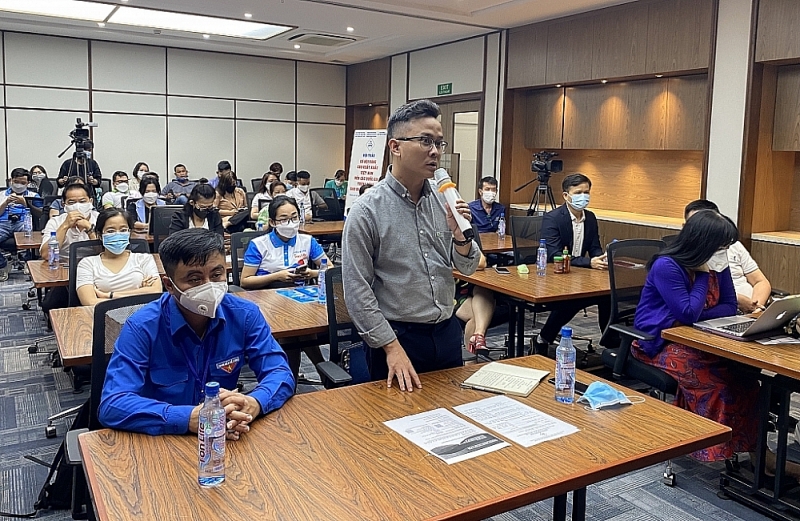Middle East market has lots of export potential for Vietnamese businesses
The Middle East (including 16 countries) is emerging as a potential export market for Vietnamese businesses with a large population (about 400 million people) and a high standard of living.
 |
|
Representative of Ba Huan Co., Ltd. gave opinions at the workshop. Photo: T.D |
Big fiscal space
On the afternoon of March 17, the Workshop "Golden opportunity for Vietnamese exports to Middle Eastern countries after the Covid-19 pandemic" was held.
Mr. Nguyen Tuan, Deputy Director of the Investment and Trade Promotion Center (ITPC) said that the trade in the Middle East region prospered and grew stronger after the global economic crisis in 2008-2009 due to the recovery of the world economy and the increase in oil prices.
At the same time, foreign direct investment (FDI) inflows into this sector also increased, reaching US$681.444 billion in 2010 and US$932.404 billion in 2018. Foreign investment by Middle Eastern countries also increased from US$234,369 billion to US$542,455 billion during the same period.
These countries have huge import demand (ranging from US$2 billion to US$8 billion) for items such as furniture, plastic products, grains, textiles, footwear, rubber and rubber products, meat, milk and dairy products, vegetables of all kinds, etc. These are the key products of Vietnam.
Another advantage when exporting to the Middle East was that the import tax rate was only from 0-5% for goods imported from outside the group. Because of this, the Middle East has become a potential market for Vietnam.
On the other hand, Vietnam's trade relations with the Middle East region mainly focused on the countries of the Gulf Cooperation Council (GCC). GCC countries have an open economy, develop foreign trade, attract foreign investment, tourism, services, diversify the economy, and promote imports and exports.
Mr. Ngo Toan Thang, Ambassador of Vietnam in Kuwait, said that opportunities for Vietnamese businesses in the GCC market were wide open with many advantages. The GCC bloc has large purchasing power and high solvency thanks to abundant financial resources. The structure of GCC's import and export products was suitable for Vietnam's strong export products. The import tariff of GCC was also quite low.
However, the proportion of these products of Vietnam in the import structure of Middle Eastern countries was still low, not commensurate with the potential of the two sides. Besides that, the agricultural sector of the Middle East was still underdeveloped due to harsh natural conditions; the manufacturing industry was difficult to develop so this area still had to import a lot of food and consumer goods.
Statistics show that these countries imported about 80% of food items, equivalent to about US$40 billion/year. By 2035, the total value of food imports from Middle Eastern countries is expected to increase to US$70 billion/year.
Make good use of export opportunities
As reflected at the conference, currently, many Vietnamese enterprises in general and Ho Chi Minh City, in particular, were still facing difficulties in accessing the Middle East market such as lack of information, barriers in logistics and international payments. Therefore, businesses needed to receive support from Vietnam's diplomatic agencies in the region as well as trade and investment promotion agencies such as ITPC.
Mr. Nguyen Tuan said that it was expected that in the future, ITPC would continue to deploy market survey missions, connect trade and meet modern distribution channels in the Middle East, especially in Vietnam's two strong export markets today that were the United Arab Emirates (UAE) and Kuwait.
Speaking at the workshop, Mrs. Nguyen Thi Ngoc Hang, Marketing Director of Halal Certification Office - HCA Vietnam, said that the benefits of Halal certification (an assessment program following international standards for products/services) was enormous. It helped businesses meet the requirements when exporting to Muslim countries; build consumer confidence, chosen by consumers (both Muslims and non-Muslims) around the world for meeting both quality control and food safety and hygiene requirements, thereby increasing the target audience of the product; help businesses increase opportunities to participate in the global supply chain of Halal materials and products.
The Halal industry was now very diverse with many products and services, which was an opportunity for businesses to export items such as confectionery; food and beverages; herbal; and cosmetics.
Mrs. Nguyen Thi Ngoc Hang also gave notes for businesses when participating in the Halal certification program. Accordingly, when preparing to register, businesses needed to apply Halal in production, paying attention to choosing Halal materials. During the Halal assessment, the review body would conduct traceability of the raw materials and all ingredients present in the manufacturing process. After being certified, businesses also needed to pay attention when releasing new products, changing raw materials to ensure the integrity of Halal in the production process.










